The Liberated Spirit: Ancient Aztec Poetry
|
|
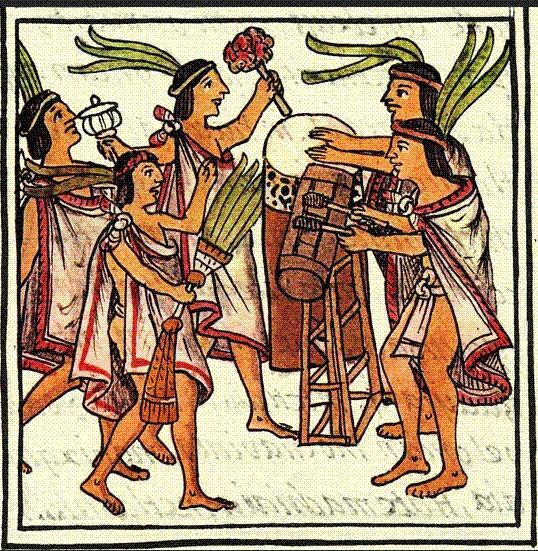
Aztec Poets and Musicians
*
Español
August 25, 2024
by Philip Gambone
The literary output of ancient Mexico is extraordinarily fertile. What is more, no other pre-Conquest people left such a large and varied body of literature as the Nahua of Central Mexico, the people we commonly call the Aztecs. Theirs was a literature largely kept alive through oral tradition, in which they passed down their stories and poetry by word of mouth. The "sages of the word," those learned men who memorized and recited this literary heritage, were aided by amoxtli, picture books that helped to jog their prodigious memories. (In a previous article, "The Path of the Codex" in the January 28, 2024 issue of Lokkal, I described how these Aztec "books" recorded literary language.)
After the Spanish Conquest, some of the early missionary friars who came to Mexico to evangelize the Indigenous people took a keen interest in their literature and culture. They learned Náhuatl, the language of the Nahua, and using the Latin alphabet, took down from dictation the poems, songs, stories, and myths that the sages "read" to them from the books. Miguel León-Portilla, an eminent Mexican anthropologist and historian, writes that friars like Bernadino de Sahagún deemed the songs and ancient stories of the Nahua "as worthy of preservation as had been the compositions of other 'pagans' such as the Romans and the Greeks."

Miguel Léon-Portilla (1926-2019)
*
Tragically, much of the work of the early friar-chroniclers has been lost, destroyed by other clerics who thought Aztec literature was sacrilegious and by secular authorities who feared that evidence of a rich, sophisticated Indian culture would undermine the claim that the Spanish were bringing a superior culture and religion to a pagan world. And yet, despite the destruction of so many documents, a good amount of early Mexican literature, including poetry, survives. What survives turns out to be both fascinating and delightful.
"They, all the lords, had their singers who composed songs about the achievements of their ancestors and of themselves," wrote the Dominican friar, Diego de Durán, in his Historia de las Indias de Nueva España (1581). At first, as Durán listened to the songs, they seemed obscure, nonsensical. "Yet afterwards," he said, "when talking about them and discussing them, I have found them to make wonderful sense. I have heard those songs many times in dances at the open air, which … gave me much contentment." In addition to these heroic poems, the Nahua composed many lyric poems—poems about springtime, flowers, birds and fish, about orphanhood, women, and friendship. They also produced "provocative songs," i.e., erotic songs (cantos traviesos).
Nahua poetry comes from "a tradition of fused vision," write Edward Kissam and Michael Schmidt, two poets who assembled a small anthology of Aztec poems. Aztec poetry, they noted, is "almost magical or visionary," tying together multiple levels of thought: literal, philosophical, mythical, and religious. "The poetry tries to integrate these levels in a single statement." As an example, they point to these two lines: "The body makes a few flowers / Then falls away withered somewhere." This, they say, "can be seen as referring to the ephemerality of life, to self-sacrifice, to the creation of poems, to the generation of children." León-Portilla puts it this way: The poetry of the Aztecs derived from a peculiar type of knowledge, "the fruit of authentic inner experience…. Only he who comes under the divine influence, which scatters flowers and songs among men, is able to speak of 'truth on earth.'"
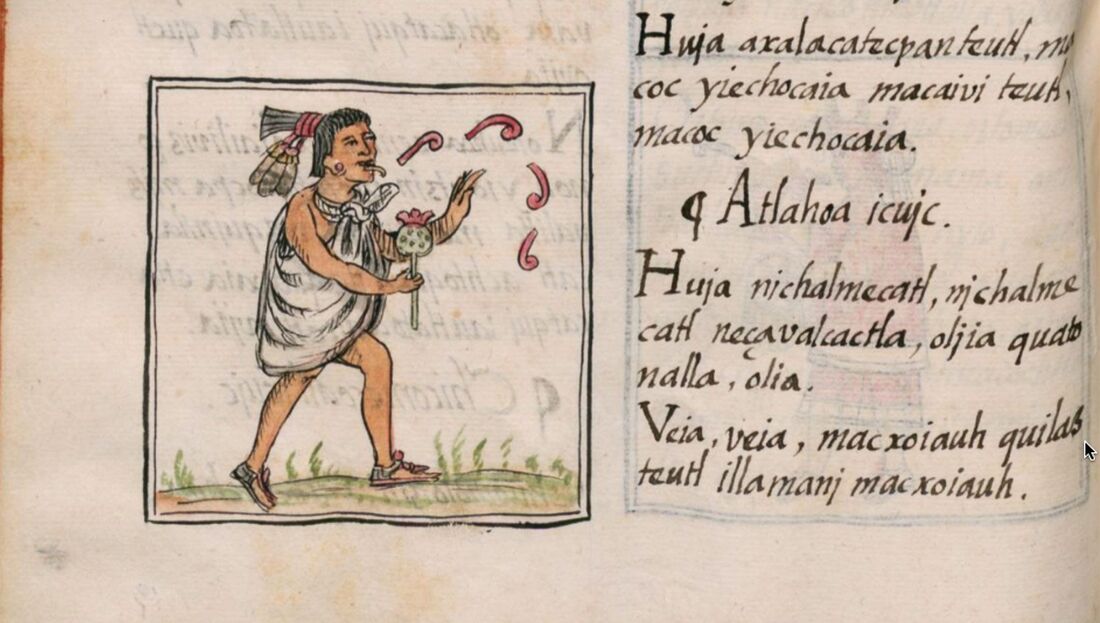
Nahuatl text
*
Flowers are a recurrent image in Aztec poetry. "The texts always use it in a clearly spiritual meaning," writes Laurette Séjourné, another scholar of Aztec culture, "and we have seen that the flower of the body, which the religious colleges had the mission of making bloom, can only refer to the soul."
|
|
|
|
From heaven, ah, come
Good flowers, good songs.
They put away our care,
They put away our pain.
| |
|
|
The chief message of Aztec poetry is that life on earth is ephemeral. The poets know that "an inescapable destiny leads man to the Region of the Dead," writes León-Portilla.
|
|
|
|
Will I have to go like the flowers that perish?
Will nothing remain of my name?
Nothing of my fame here on earth?
At least my flowers, at least my songs!
Earth is the region of the fleeting moment.
| |
|
|
In the face of the transitory nature of life, Aztec poets became "obsessed with finding an authentic meaning for human activity and thought," continues León-Portilla. "The inevitable answer, as the Náhuatl poets and wise men must have conceded, was to live life on earth to the fullest—to derive the maximum pleasure possible." In this way, Xochipili ("flower prince"), the Aztec god of flowers, song, dance, and games, came to represent the liberated spirit.
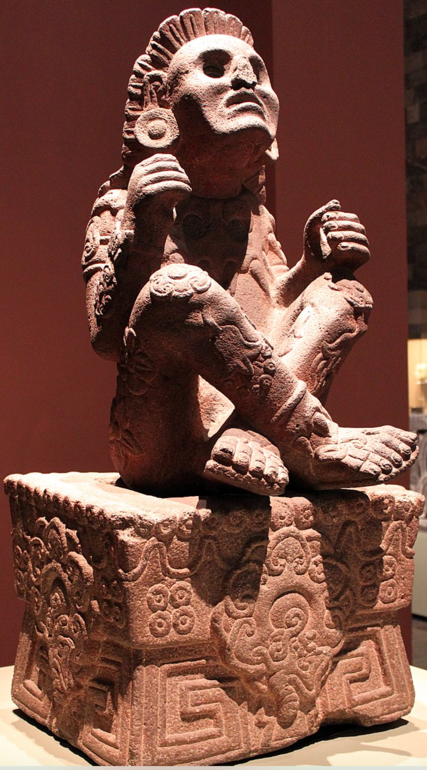
Xochipilli - god of art, games, dance, flowers, and song
*
Among the Aztec poems that have come down to us is an "ode to pleasure" purportedly written by Tlaltecatzin, a fourteenth-century lord of Cuauhchinanco, in the present state of Puebla. His song about pleasure is "interwoven with an anguished sense of the loss of oneself through death," says León-Portilla in his book Fifteen Poets of the Aztec World. In the poem, Tlaltecatzin speaks to an ahuiani or "rejoicing one," whom León-Portilla discreetly calls a "public woman." There is ample documentation of these rejoicing ones in the Aztec picture books and in the later Spanish codices. One codex, for example, includes a poem about an ahuiani who
|
|
|
|
With her body she gives pleasure,
She stands up and waves,
Knows how to primp ...
With her hands she makes signs,
With her eyes she beckons.
She moves her eyes in an arch,
She smiles, goes about laughing,
Shows her charms.
| |
|
|
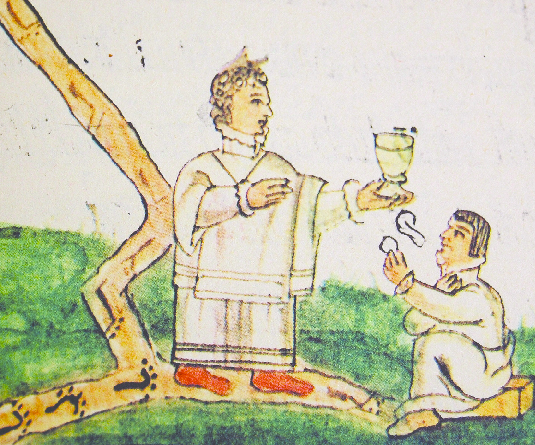
Ahuiani
*
In Tlaltecatzin's Song of Pleasure, as he addresses his rejoicing one, he becomes aware that she, and all earthly pleasure, will eventually die:
|
|
|
|
Sweet woman,
Precious flowers of toasted maize,
You only lend yourself,
You will be abandoned,
You will have to go away,
You will become fleshless.
| |
|
|
One of the most outstanding collections of ancient Mexican poetry, and the largest, is the Cantares mexicanos, an anthology assembled sometime in the 16th century, probably by an Indian in the service of Sahagún or another friar. The anonymous compiler wrote down the poems in classical Náhuatl, using the Latin alphabet. The manuscript, forgotten for centuries, was discovered in the mid-19th century, when it began to be translated and studied.
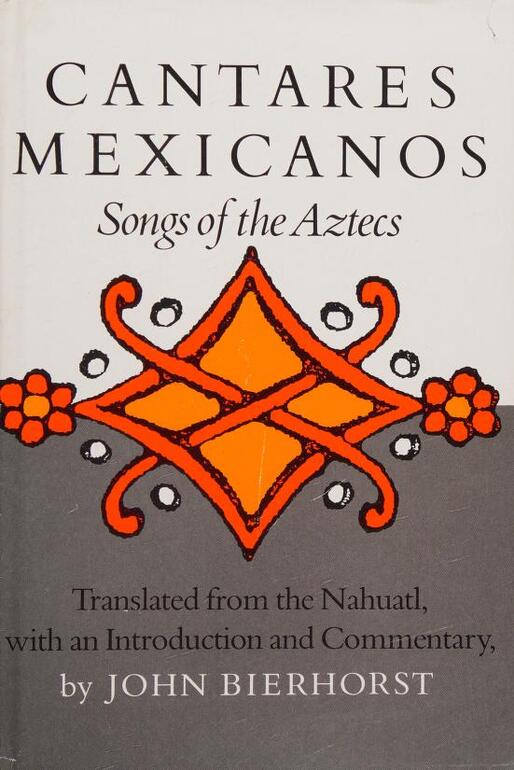
The date of the assembled manuscript (sometime after 1565) means that Christian influences crept into some of the poems in Cantares mexicanos. John Bierhorst, another scholar of ancient Mexican poetry, says that some of the militaristic subject matter in the original Aztec poems and songs was replaced with references to Bible stories and saints' lives "in the hope that these might supplant the idolatrous [elements]." Other poems in Cantares mexicanos recall the events of 1519-1521, when Cortés conquered the Aztecs:
|
|
|
|
Gather your strength
Go fight, O Commander, O Temilotzin.
Castillians and Chinampanecs are coming in with boats!
Tenochans are surrounded,
Tlatelocans are surrounded.
| |
|
|
Among the outstanding Aztec poets in the Cantares mexicanos (and in other codex collections as well) is Nezahualcoyotl (1402-1472), who was one of the great rulers of Tetzcohco (Texcoco). During his reign, culture and the arts flourished, "a period of magnificence," writes León-Portilla, "during which Nezahualcoyotl planned and inaugurated new palaces, temples, and botanical and zoological gardens." The king was also a poet of great finesse, a master of both song and wisdom.
While there is some dispute about whether all the poems attributed to Nezahualcoyotl were actually composed by him, there are several that are pretty much universally acknowledged to be authentic. Like so much Aztec poetry, Nezahualcoyotl's reveals an anxiety about the fleetingness of life:
|
|
|
|
I, Nezahualcoyotl, ask this:
Is it true one really lives on the earth?
Not forever on earth,
Only a little while here.
Though it be jade it falls apart,
Though it be gold it wears away,
Though it be quetzal plumage it is torn asunder
Not forever on earth,
Only a little while here.
| |
|
|
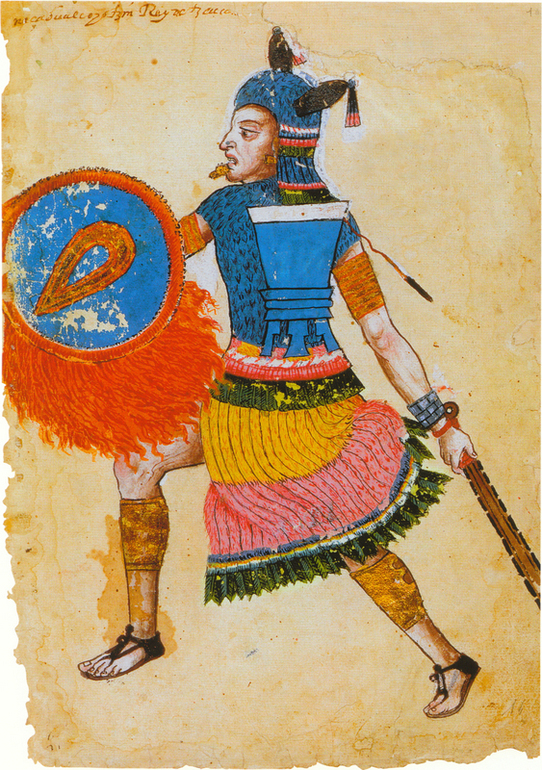
Nezahualcoyotl from the Codex Ixtlilxochitl
*
But in another poem, he declares that an alternative way exists, a way that never dies. It is the way of "flowers and songs," of poetry and art, which he will bestow upon future generations:
|
|
|
|
My flowers will not come to an end,
My songs will not come to an end,
I, the singer, raise them up;
They are scattered, they are bestowed ...
Even though flowers on earth
May wither and yellow,
They will be carried there,
To the interior of the house
Of the bird with the golden feathers.
| |
|
|
Even in translation, the lyric poetry of the Aztecs offers modern readers an abundance of delights. Here's one more poem, composed by Temilotzin, a prince of Tzilacatlan, who fought against the conquistadors. It is about making friends and is startlingly modern in its romanticism. The English translation is by Edward Kissim.
|
|
|
|
I come
to weave you in my chains of feathers.
I spread divans of tzinitzcan feathers,
crown you with the feathers of the bright macaw.
Brightness robes you.
In trembling green quetzal feathers
I bind you to each other, my gathered friends!
Our love grows stronger, singing.
I carry friendship to the palaces
where we can lie content until we journey to the dead.
Then we will have loaned love to one another.
I come
to plant my songs,
make them grow for you.
God sent me, I possess his flowers:
my duty to weave love chains on the earth.
| |
|
|
"In the native literatures of Mexico," León-Portilla concludes, "remains the message of those who knew how to give meaning to life and the enigma of death, the ultimate reality and the universe. The texts, poems, and hymns which survive are witness to the truth spoken by the ancient wise men who had so often repeated that their flowers and songs, the art of the indigenous world, would exist forever."
Those who wish to read more ancient Nahua/Aztec poetry might want to consider the following books: Flower and Song: Poems of the Aztec Peoples, Edward Kissam and Michael Schmidt (1977); Fifteen Poets of the Aztec World, Miguel León-Portilla (1992); Cantares Mexicanos: Songs of the Aztecs, John Bierhorst (1985); Trece poetas del mundo azteca, Miguel León-Portilla (1967); and La tinta negra y roja: antología de poesía náhuatl, Miguel León-Portilla (2008).
**************

Philip Gambone, a retired high school English teacher, also taught creative and expository writing at Harvard for twenty-eight years. He is the author of five books, most recently As Far As I Can Tell: Finding My Father in World War II, which was named one of the Best Books of 2020 by the Boston Globe. His new collection of short stories, Zigzag, will be published in October.
**************
*****
Please contribute to Lokkal,
SMA's online collective:
 ***
***
Discover Lokkal:
Watch the two-minute video below.
Then, just below that, scroll down SMA's Community Wall.
Mission

Visit SMA's Social Network
Contact / Contactar

|
|
|
|
| | |
Click ads
Contact / Contactar
 copyright 2025
copyright 2025
|
